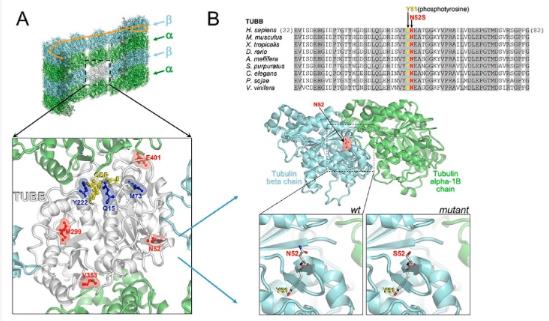What is TUBB Protein
The TUBB protein, or Tubulin Beta Class I protein, is a molecule that plays a role in our bodies with essential functional roles that include the formation of microtubules. These are the building blocks of the cytoskeleton and are crucial for the ability of cells to maintain their shape, grow, and divide.
The TUBB protein was discovered in the 1970s and has since been the focus of numerous molecular biology and genetic studies. This interest is centered on the substantial functional diversity of TUBB, combined with the universality of its basic structure. The discovery of TUBB protein opened up a new window into our understanding of fundamental cellular processes.
The TUBB protein is encoded by the TUBB gene located on chromosome 6p21.33. The TUBB gene comprises over 1,200 base pairs and approximately 35 exons resulting in five transcript variants. The protein comprises 445 amino acids, closely related to the alpha-tubulin structure, forming a beta-alpha-tubulin dimer. This dimer is the building block of microtubules, which are made by the head-to-tail addition of these dimers in an arrangement that gives the microtubule a polar structure.

Fig1. TUBB Mutation (Sferra, A. et al, 2019)
Function of TUBB protein
Functionally, the TUBB protein has a key role in cellular structure, intracellular transport, and cell division. As a primary component of microtubules, it allows vesicles, organelles, and chromosomes to be transported through intracellular highways. During cell division, it helps in the formation of the mitotic spindle required for the separation of chromosomes into two daughter cells. TUBB proteins are also important in forming the axonal and dendritic networks in neurons that underpin the structure and function of the nervous system.
TUBB protein related signal pathway
Many signaling pathways rely on the operation of the TUBB proteins. One example is the JNK pathway (Jun N-terminal kinase), where JNK phosphorylates BimEL, a pro-apoptotic protein associated with TUBB. Following the phosphorylation, BimEL dissociates from the microtubules, triggering the process of apoptosis, or programmed cell death. Thus, TUBB proteins are involved not only in cell growth and division but also in programmed cellular death.
TUBB protein related diseases
The wide range of functionalities of TUBB proteins means that they are critically implicated in a range of diseases. Mutations in TUBB proteins have been correlated with several neurological disorders. For example, mutations have been identified in patients with various types of epilepsy. Moreover, mutations can result in congenital fibrosis of the extraocular muscles, a condition that results in restricted eye movement. TUBB proteins also play a central role in cancer due to their involvement in cell division and apoptosis. TUBB mutations can result in increased resistance to microtubule-targeting drugs that are often used in cancer therapy.
TUBB protein's applications in biomedical
In terms of the application of TUBB proteins in the disease management and treatment, they serve as the target of several pharmaceutical therapies, especially for the treatment of cancer. Most chemotherapy drugs, such as taxol and vinblastine, work by perturbing the function of microtubules, thus obstructing cancer cell division. Other research areas include Alzheimer's disease and Parkinson's disease, considering the role of TUBB proteins in the formation of neuronal networks.
In summary, the TUBB protein, one of the critical components of the cell cytoskeleton, holds a central position in the complex orchestration of cellular processes. Its impact is evident in cell division, intracellular transport, signal translation, and programmed cell death. The centrality of its role is highlighted by the range of diseases that are associated with TUBB mutation, from cancer to neurological disorders. The diverse functionality and universal involvement of TUBB proteins mean that understanding them better could unlock new frontiers in treatment and disease management. Hence, continued research and exploration of TUBB proteins stands to produce big breakthroughs in biomedical sciences, promising exciting developments in the future.
Our Featured Products
| Cat.No. | Product Name | Species | Source (Host) | Tag |
|---|---|---|---|---|
| TUBB-100HFL | Recombinant Full Length Human TUBB Protein, C-Flag-tagged | Human | Mammalian cells | Flag |
| TUBB-3829H | Recombinant Human TUBB Protein, MYC/DDK-tagged | Human | HEK293 | Myc/DDK |
| TUBB-3923H | Recombinant Human TUBB Protein, His-tagged | Human | E.coli | His |
| TUBB-4838R | Recombinant Rhesus Macaque TUBB Protein, His (Fc)-Avi-tagged | Rhesus Macaque | HEK293 | His (Fc)-Avi |
| TUBB-6867C | Recombinant Chicken TUBB | Chicken | Mammalian Cell | His |
Reference
- Sferra, A., Petrini, S., Bellacchio, E., Nicita, F., Scibelli, F., Dentici, M. L., Alfieri, P., Cestra, G., Bertini, E. S., & Zanni, G. (2019). TUBB Variants Underlying Different Phenotypes Result in Altered Vesicle Trafficking and Microtubule Dynamics. International Journal of Molecular Sciences, 21(4), 1385. https://doi.org/10.3390/ijms21041385

